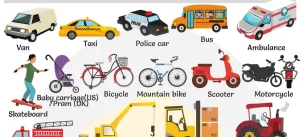Any machine that transports people, animals (live cargo), or cargo is a vehicle. Cars, trucks, buses, wagons, motorbikes, bicycles, boats, airplanes, and spacecraft, for example, are vehicles. Some dictionaries, however, strain that the term most effective consists of gadgets that transports people, stay cargo, or items on land.

Most people generally tend to apply the phrase most effective whilst relating to motor vehicles, i.e., cars, trucks, and different street visitors transportation machines.
Vehicle in medicine
- Drugs
In the world of medicine, a vehicle is an inactive substance that we integrate with an energetic aspect to facilitate administration, i.e., it’s miles an excipient or menstruum. In different words, in a medication, the vehicle is the substance that has no healing movement or effect.
- Infectious diseases
The time period may talk to an inanimate substance with the aid of using which a bacterium, virus, or every other infectious agent passes from one host (inflamed host) to every other (inclined host).

The US CDC (Centers for Disease Control and Prevention) says the following regarding the term in an epidemiological setting:
“Vehicles that can in a roundabout way transmit an infectious agent consist of meals, water, biologic products (blood), and fomites (inanimate gadgets consisting of handkerchiefs, bedding, or surgical scalpels). A vehicle may also passively deliver a pathogen — as meals or water may also deliver hepatitis A virus.”
The relaxation of this newsletter specializes in the time period whilst it refers to a transportation device of people, animals, or items.
Legal definition (transportation device)
Vehicles are devices of conveyance (transportation). They may also consist of any form of conveyance we use for transporting shipment, stay cargo, or human passengers with the aid of using land, air, or water. Anything that runs on land the use of tires is a vehicle.
The which means of the time period can range barely relying at the context, area of the economy, or profession. USLegal says the subsequent approximately vehicles in a legal setting:
“Vehicle consists of any mechanical device on wheels, designed especially for use, or used, on highways, besides motorized bicycles, vehicles propelled or drawn with the aid of using horses or human power, or vehicles used completely on constant rails or tracks, or cotton trailers or motorized wheelchairs operated with the aid of using handicapped persons.”
History of engine-powered vehicles
- Steam-powered
In 1672, Ferdinand Verbiest (1623-1688), a Flemish scientist, a member of the Jesuit mission in China, constructed a steam-powered 26-inch lengthy scale version toy for the Kangxi Emperor. However, it did now no longer deliver human beings or cargo. Therefore, technically, it became now no longer a vehicle.
In 1769, Nicolas-Joseph Cugnot (1725-1804), a French inventor, constructed the primary complete scale, self-propelled mechanical vehicle. His invention became a steam-powered tricycle. His vehicles had a hassle with preserving steam strain and having continuous get right of entry to to a regular water supply.
Richard Trevithick (1771-1833), a British inventor and mining engineer, created the first steam-powered, functioning street vehicle. He referred to as it the Puffing Devil. However, because it couldn’t hold steam electricity for lengthy, it had no realistic use.

During the first half of the 19th century, there had been numerous special varieties of steam-powered street vehicles, along with steam rollers, phaetons, steam buses, and steam cars.
- Internat combustion engine and electric powered car
Nicéphore Niépce (1765-1833) and his brother Claude Niépce (1763-1828), French inventors, created what they referred to as a Pyréolophore. Created in 1807, it became the world’s first internal combustion engine. In the equal year, Swiss inventor François Isaac de Rivaz (1752-1828) created an inner combustion engine. He used it to create the world’s first combustion engine vehicle.
In 1881, French electric engineer Gustave Trouvé (1839-1902) created the primary electric powered car.
- First modern car vehicle
German engine fashion dressmaker and automotive engineer Karl Benz (1844-1929) is mentioned withinside the car area these days because the inventor of what we recognize because the current vehicle. In 1886, he received a patent for the motorcar.
Today, we’re starting to see self-driving cars or self sustaining vehicles. As artificial intelligence will become extra state-of-the-art and aeronautical engineering advances, how lengthy will or not it’s earlier than we journey round in our very own personal, self-piloting flying machines?

